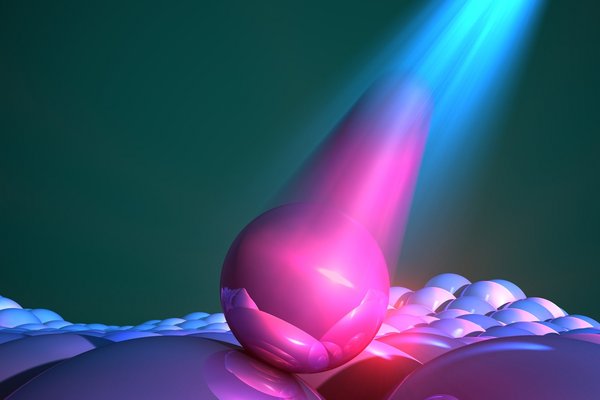New technique measures near-perfect performance in low-cost semiconductors
Tiny, easy-to-produce, particles, called quantum dots, may be soon take the place of more expensive semiconductors in advanced electronics found in solar panels, camera sensors, and medical imaging tools. Quantum dots have been limited by long-standing uncertainties about their quality, but a new measurement technique developed by researchers at Stanford University, the University of California at Berkeley and the University of Technology in Eindhoven may dissolve those doubts, according to a new study published in Science.

A close-up artist's rendering of quantum dots emitting light they've absorbed. Photo: Ella Marushchenko
“Using this new technique, we are able to produce near-perfect and low-cost semiconductors, called quantum dots, that meet quality standards set by more expensive alternatives”, according to Yoeri van de Burgt, assistant professor at the Department of Mechanical Engineering of the TU/e and co-author of the paper.
The researchers focused on how efficiently quantum dots reemit the light they absorb, one telltale measure of semiconductor quality. While previous attempts to figure out quantum dot efficiency hinted at high performance, this is the first measurement method to confidently show they could compete with single crystals.
Paul Alivisatos, professor of Nanoscience and Nanotechnology at Berkeley and senior author of the paper, emphasizes how the measurement technique could lead to the development of new technologies and materials that require knowing the efficiency of our semiconductors to a painstaking degree.
“These materials are so efficient that existing measurements were not capable of quantifying just how good they are. This is a giant leap forward,” said Alivisatos. “It may someday enable applications that require materials with luminescence efficiency well above 99 percent, most of which haven't been invented yet.”
Between 99 and 100
Being able to forego the need for pricey fabrication equipment isn’t the only advantage of quantum dots. Even prior to this work, there were signs that quantum dots could approach or surpass the performance of some of the best crystals. They are also highly customizable. Changing their size also changes the wavelength of light they emit, a useful feature for color-based applications such as tagging biological samples, TVs or computer monitors.
Despite these positive qualities, the small size of quantum dots means that it may take thousands of them to do the work of one large, perfect single crystal. Making multiple quantum dots means more chances for something to grow incorrectly, more chances for a defect that can hamper performance. It could be nearly impossible to make thousands of quantum dots collectively perform as well as a large single crystal. Or so researchers thought.
Techniques that measure the quality of other semiconductors previously suggested quantum dots may be very efficient – meaning that above 99 percent of the light that they absorb is emitted – but the researchers needed a measurement technique better suited to precisely evaluating these particles.
The researchers’ technique involved checking for excess heat produced by energized quantum dots, rather than only assessing light emission because excess heat is a signature of inefficient emission. The technique was 100 times more exact than other options. They found that groups of quantum dots reliably emitted about 99.6 percent of the light they absorbed (with a potential error of 0.2 percent in either direction), which is comparable to the best single crystal emissions.
Contrary to concerns, the results suggest that the quantum dots are strikingly defect-tolerant and that their shape should guide the design for new light emitting materials. The measurement technique is also the first to firmly resolve how different quantum dot structure compare to each other – quantum dots with precisely eight atomic layers of a special coating material within their box emitted light the fastest, an indicator of superior quality.
David A. Hanifi et al., Redefining near-unity luminescence in quantum dots with photothermal threshold quantum yield